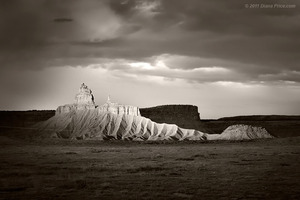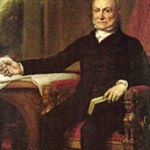Not to be a negative Nancy, but if you aspire to black and white landscape photography, no one can ever surpass the master, Ansel Adams. But that doesn’t mean you can’t make your mark as well, or put your own unique spin on the black and white landscape photograph. Or just enjoy the art of fine landscape photography, and maybe find a little creative inspiration.
It Doesn’t Have to be “Pretty”
One of my favorite photos, and one of the most provocative, is a shot of a dead coyote by a stretch of desolate highway. And it’s the shot that gets the most reaction from people, good and bad (more good if you can believe that.) Irony is one of my favorite things, and the juxtaposition of the beautiful landscape and the dead coyote is the kind of contrast I live for. The coyote is also a symbol of the southwest, and has been associated with traditional cultures there…which have been “run over” by contemporary society. That particular image was recently selected for and displayed at an OpenShutter Gallery show juried by National Geographer photographer Steve McCurry.
Off the Scale
Use objects in the foreground to either enhance scale, or play with it. Use flowers or greenery in the foreground to make those typical landscape scenes not quite so predictable.
Lens Flare
For late afternoon nostalgia, a little lens flare can be a landscape photographer’s best friend. Especially when you are framing your landscape through some glass. I shot a broken down vintage car in late evening with the sun coming through the cracked glass — beautiful. In that broken down way some of us so love.
Black Skies Ahead
Ah, Grasshopper, Confucius say if you want black, contrasty skies, use ancient red filter trick. Your digital camera has an option in monochrome if you don’t have the screw on your lens variety. (Caution: red filters will add grain, or “noise” to your images, and you may need to do some noise reduction in photoshop or a program specifically for noise reduction.)
Hey, Shouldn’t That Be in Color?
For some of us, the answer is always (or almost always) a resounding “NO.” I have a shot of a horse in a southwest desert scene with a rainbow in the background — the kind of shot you would normally think has to have color. Hey, it’s got a rainbow! But dare to do the unexpected. All that shot needs is a horn on the pony and this could be straight outta the 70s or 80s…but somewhat more sophisticated than the velvet, black light poster version. Or at least I like to think so.
Fill ‘Er Up…With Light
Fill flash isn’t just for indoors any more. Try some fill flash outside, underexposing your scene a bit so the background goes a bit dark and the flash makes your subject really “pop.” This works especially well on overcast days or backlit subjects. Or if you want to emphasize something in the foreground and de-emphasize the background.
The Grand Mistress of Lighting
No matter how many lighting classes you take or fancy gadgets you buy, Mother Nature is always gonna kick your butt in the “Best Lighting” category. So watch for her gifts — which may not be offered long — and get outta her way. I saw an amazing sliver of light on a desert mesa while I was driving, and by the time I pulled over and got out of the car, I had about 30 seconds before it was gone. Act quick when you see the moment.
Sure, you’re no Ansel Adams, but you’re you, and bring your own unique style to the fine art of landscape photography. Like no one else but you can.





